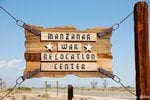evangilder
"Shooter"
The story of the internment of more than 100,000 Japanese Americans during World War II hasn't always gotten widespread attention in the United States. But with construction beginning on the new Topaz Museum and Education Center in Utah, another step is being taken to keep the memory alive.
Read the full story below:
Japanese American internment camp museum breaks ground in Utah - latimes.com
Interesting timing. For years, we have driven past Manzanar, another Japanese American internment camp. Tomorrow, we will be visiting there. We stopped once before there was a museum or anything there. I have been getting a calling to visit again for a number of years. I will post some photos later in the week.




















